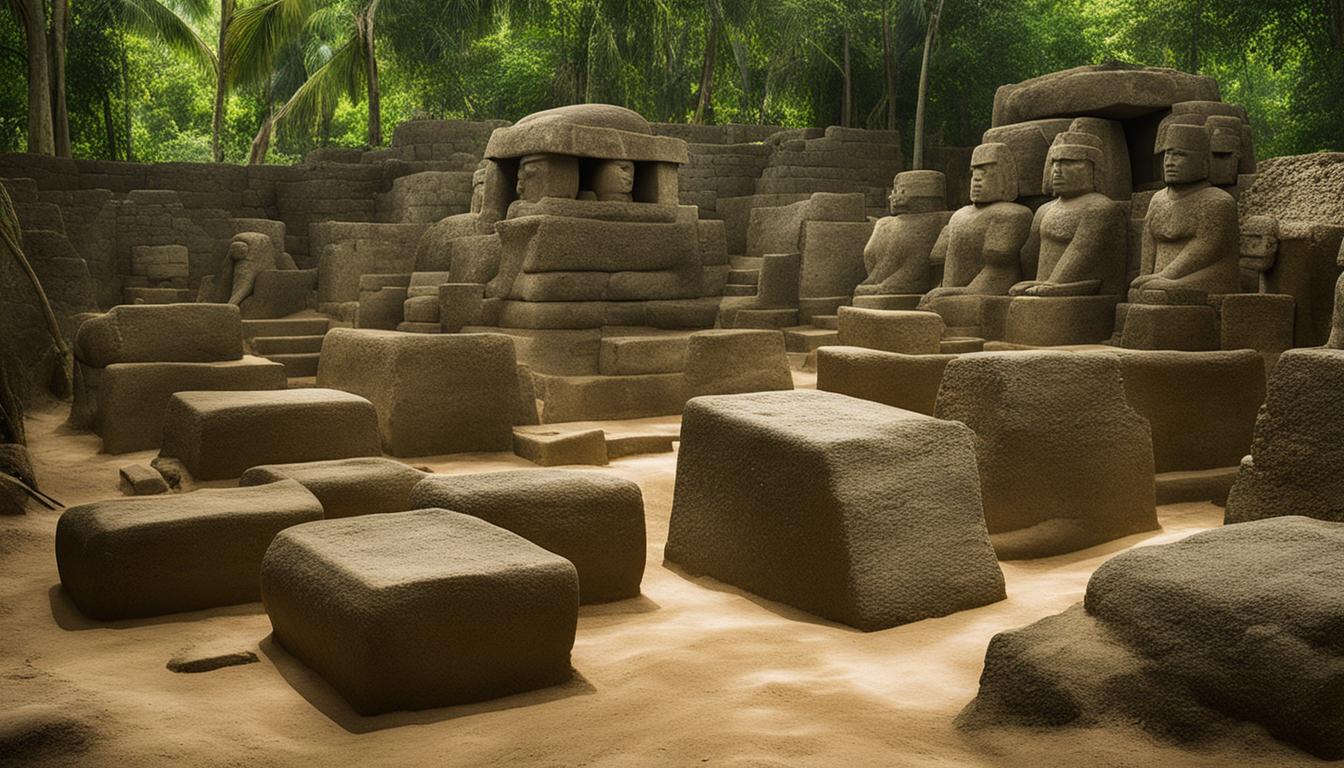The Olmec civilization, one of the earliest civilizations in America, had a deep understanding and usage of magnetic technology. They used magnetized stones to create sculptures and structures, potentially as a way to represent the life force of the deceased. This knowledge of magnetism predates the ancient Greeks and may have been transferred through trade with other civilizations.
Key Takeaways:
- The Olmec civilization in America utilized magnetic technology in their sculptures and structures.
- They used magnetized stones to represent the life force of the deceased.
- Their knowledge of magnetism predates the ancient Greeks.
- The transfer of this knowledge may have occurred through trade with other civilizations.
Ancient Observations of Magnetism
Ancient cultures in the Americas, such as the Monte Alto people of Mesoamerica, possessed knowledge of magnetic forces long before the invention of pocket compasses. These ancient civilizations, including the Greeks, made significant observations and measurements of magnetism. The use of magnetism in sculptures suggests a deeper understanding of the properties of magnetized materials.
The Monte Alto people, for example, used magnetized stones struck by lightning to construct giant heads and sculptures. These sculptures displayed significant magnetic anomalies, with the navels of the potbellied figures exhibiting the strongest magnetic attraction. The artists intentionally shaped the sculptures to allow for the measurement of magnetism at specific points, indicating a deliberate incorporation of magnetism into their artwork.
Furthermore, the prevalence of ancient magnetism is not limited to the Monte Alto civilization. Archaeologists have discovered a magnetized bar dating back to 1400 B.C. to 1000 B.C., at San Lorenzo, an Olmec city. This bar could have served as a magnetic tool, suggesting that Mesoamerican knowledge of magnetism predates the early Greek descriptions by Thales of Miletus. To further investigate the prevalence of magnetism in early Mesoamerican cultures, magnetic testing should be conducted on Olmec head sculptures and Maya artifacts.
| Ancient Magnetic Observations | Location | Description |
|---|---|---|
| Monte Alto | Mesoamerica | The Monte Alto people used magnetized stones to construct sculptures with measurable magnetic anomalies, such as potbellied figures with strongly magnetic navels. |
| Greece | Ancient Greek civilization | Thales of Miletus observed the attraction of a magnetic lodestone to iron fragments, contributing to ancient Greek knowledge of magnetism. |
| San Lorenzo | Olmec city | Archaeologists discovered a magnetized bar dating back to 1400 B.C. to 1000 B.C., suggesting early Mesoamerican knowledge of magnetism. |
The ancient observations of magnetism in both the Americas and Greece suggest that the understanding of this natural phenomenon was not limited to a single culture or region. The utilization of magnetism in artwork and the discovery of magnetized objects from ancient civilizations highlight the widespread intrigue and fascination with this mysterious force.
Magnetism in Monte Alto Sculptures
The people of Monte Alto, an ancient culture in Mesoamerica, displayed a remarkable understanding and utilization of magnetism in their sculptures. These magnetized stones, used to create potbellied figures and large stone heads, exhibited significant magnetic anomalies. The strongest magnetic attraction was found in the navels of the potbellied sculptures. It is evident that the artists intentionally shaped the sculptures to ensure the magnetism could be measured at specific points.
This usage of magnetism in Monte Alto sculptures suggests a deeper symbolic and ritualistic significance. The magnetized stones may have represented the life force of the deceased, honoring ancestors or former community members. The magnetism in these sculptures could have served as a connection between the spiritual realm and the physical world, reflecting the beliefs and traditions of the Monte Alto culture.
| Sculpture Type | Magnetic Anomalies |
|---|---|
| Potbellied Figures | Strongest magnetic attraction in navels |
| Stone Heads | Subtle but measurable magnetic fields |
The presence of magnetism in Monte Alto sculptures raises intriguing questions about the technical knowledge and cultural practices of ancient Mesoamericans. Were these sculptures created as sacred objects, imbued with spiritual power? Or did they serve a more practical purpose, utilizing magnetism for political or social reasons? Further research and exploration into the role of magnetism in Mesoamerican cultures, such as the Maya, could provide valuable insights into the customs and beliefs of these fascinating civilizations.
Detection and Use of Magnetic Stones
The people of Monte Alto likely used lodestones, naturally occurring magnetic minerals, to detect and locate magnetized rocks. The lodestones could have been magnetite or hematite, materials commonly used by Mesoamericans for various purposes. It is speculated that the ancient Mesoamerican people may have utilized magnetized needles or other tools to detect magnetic anomalies in rocks. By incorporating magnetized rocks into their sculptures, the Monte Alto people could have reinforced political control or created the illusion of persisting life in the objects.
The use of magnetized stones in Monte Alto sculptures suggests a sophisticated understanding and intentional utilization of magnetism. The magnetic stones would have been carefully selected and strategically placed to create specific effects within the sculptures. The selection process may have involved detecting and measuring the magnetic properties of different rocks before incorporating them into the artwork. This attention to detail and intentional use of magnetism further highlights the significance of magnetic technology in Monte Alto culture.
The incorporation of magnetized stones in sculptures could have served multiple purposes. Firstly, it may have been a symbolic representation of the life force, with the magnetism representing the energy or spirit of the deceased. Secondly, it could have been a way to connect with and honor ancestors or former community members. The use of magnetism in these sculptures may have been a religious or ritualistic practice, amplifying the spiritual significance and power of the artwork. The precise knowledge and skill required to detect and use magnetized stones in this manner demonstrate the expertise and cultural importance of magnetic technology in ancient Mesoamerica.
| Advantages of Magnetically Enhanced Sculptures | Benefits of Magnetized Stones |
|---|---|
| Magnetic attraction adds a unique and captivating element to the sculptures | Ability to create an illusion of persisting life in the objects |
| Symbolic representation of the life force or spiritual energy | Enhancement of religious or ritualistic significance |
| Potential reinforcement of political control | Honoring ancestors or former community members |
The use of magnetism in ancient Mesoamerican cultures offers a fascinating glimpse into the ingenuity and creativity of these early civilizations. By harnessing the power of magnetized stones, the people of Monte Alto were able to infuse their sculptures with a deeper, symbolic meaning. Further research and analysis of magnetic artifacts and sculptures can provide valuable insights into the cultural and religious practices of these ancient societies.
Influence and Trade in the Region
The Monte Alto people, with their advanced knowledge of magnetism, had a significant influence on other cultures in the region. The discovery of potbellied sculptures similar to those found in Monte Alto in Guatemala, El Salvador, and the Mexican state of Chiapas suggests that the Monte Alto culture had a widespread impact on neighboring societies. This influence may have been due to trade and cultural exchange, which allowed the transfer of knowledge, ideas, and artistic styles.
Central American cultures, including the Monte Alto people, engaged in extensive trade networks that spanned across the region. The exchange of goods and ideas would have facilitated the spread of knowledge of magnetism and other technologies. The Monte Alto people, through their trade connections, could have influenced other cultures to adopt and incorporate magnetism into their own artistic expressions and rituals.
Trade Networks in Mesoamerica
- The Monte Alto people had access to valuable resources such as obsidian, jade, and cacao, which were highly sought after by other cultures in the region.
- By engaging in trade, the Monte Alto people were able to establish connections with different communities, allowing for an exchange of ideas and knowledge.
- The trade routes extended from the Gulf Coast of Mexico to the Maya region, creating a network of cultural and economic exchange.
“The influence of the Monte Alto culture can be seen in the similarities found in the sculptures of neighboring regions. This suggests that the Monte Alto people played a significant role in the spread of magnetism as a cultural and artistic practice.”
The influence and trade connections of the Monte Alto people highlight the interconnectedness of ancient Mesoamerican cultures. Through trade, cultural exchange, and shared artistic practices, knowledge of magnetism was disseminated and incorporated into the artistic and ritualistic traditions of various societies in the region.
Ancient Magnetism in Mesoamerica
The discovery of magnetized basalt bars at the Olmec city of San Lorenzo suggests that knowledge of magnetism was prevalent among early Mesoamerican cultures. Archaeologists uncovered a magnetized bar dating back to 1400 B.C. to 1000 B.C., predating the ancient Greek descriptions of magnetism by Thales of Miletus. This finding indicates that Mesoamerican societies had a deep understanding of magnetic properties long before the Greeks.
To further investigate the prevalence of magnetism in early Mesoamerican cultures, magnetic testing should be conducted on Olmec head sculptures and Maya artifacts. This would provide valuable insights into the ancient use of magnetism and its symbolic significance. The discovery of magnetized stones and sculptures highlights the advanced understanding of magnetism by the Mesoamericans and suggests that magnetism played a significant role in their culture and rituals.
In the ongoing exploration of ancient magnetism, it is crucial to compare and contrast the knowledge and use of magnetism between different civilizations. The Olmec civilization’s understanding of magnetism predates that of the ancient Greeks, challenging the long-held belief that the Greeks were the first to observe and describe magnetic phenomena. By examining the prevalence of magnetism in other Mesoamerican cultures, we can gain a deeper understanding of how different civilizations harnessed the forces of nature.
| Table 1: Comparison of Magnetism in Ancient Cultures | Mesoamerica (Olmec) | Ancient Greece (Thales of Miletus) |
|---|---|---|
| Observation of magnetism | Pre-dates ancient Greek descriptions | Described by Thales of Miletus |
| Use of magnetized stones | Creation of sculptures and structures | Knowledge of attraction between magnetic materials |
| Symbolic significance | Representation of the deceased and community rituals | Not explicitly associated with rituals |
Magnetism in Ancient Greece: Thales of Miletus
The ancient Greeks, particularly the philosopher Thales of Miletus, were among the earliest known observers and speculators of magnetism. Thales is credited with describing the attraction of a magnetic lodestone to iron fragments, laying the foundation for further exploration into the properties of magnetism. While Thales’ observations are well known, it is likely that other ancient cultures also had some understanding of magnetism. The discovery of ancient American cultures’ knowledge of magnetism, as discussed in previous sections, suggests that this understanding could have existed in regions such as Mesoamerica even before the ancient Greek descriptions.
Thales emphasized the ability of a magnet to move iron and also noted that rubbing amber generates static electricity, showing a connection between two fundamental forces of nature.
The study of magnetism in ancient Greece goes beyond Thales’ work. Ancient Greek philosophers, including Aristotle and Pliny the Elder, further explored the properties and applications of magnetism. Aristotle, in particular, conducted experiments with magnetized iron and lodestones to understand their effects on various substances. The knowledge gained from these observations and experiments laid the groundwork for the development of magnetic compasses and navigational aids in later centuries. While the ancient Greeks had a significant contribution to the understanding of magnetism, the discovery of ancient cultures’ knowledge in other parts of the world suggests that this knowledge was not exclusive to Greece.
| Contributions of Ancient Greece to the Study of Magnetism | Contributions of Ancient American Cultures to the Study of Magnetism |
|---|---|
| The observation and description of the attraction between a magnet and iron fragments. | The creation of magnetized sculptures and structures using magnetized stones. |
| Exploration of the effects of magnetism on various substances. | The use of lodestones and magnetized stones as artistic and ceremonial elements. |
| The foundation for the development of magnetic compasses and navigational aids. | The integration of magnetism into cultural and religious practices. |
The discovery of ancient cultures’ knowledge of magnetism, both in ancient Greece and other regions of the world, adds to the historical mystery surrounding this phenomenon. The properties of magnetism have fascinated scientists and philosophers for centuries, and the exploration of its origins and applications continues to shed light on the ingenious ways in which ancient civilizations harnessed the forces of nature.
Magnetism as a Historical Mystery
The properties of magnetism have puzzled scientists and philosophers for centuries. Its invisible force and ability to attract or repel objects have captivated the human imagination throughout history. From ancient civilizations to modern-day researchers, the understanding of magnetism remains an ongoing quest for knowledge.
Magnetism has been a subject of fascination in various cultures, from the ancient Greeks to the Olmec civilization in Mesoamerica. The discovery of ancient cultures’ knowledge of magnetism, such as the Monte Alto people in Mesoamerica, highlights the enduring mystery surrounding this phenomenon.
“Magnetism has long been an enigma, defying easy explanation. Its influence in shaping the beliefs and practices of ancient civilizations underscores the deep-rooted fascination with this force of nature.”
Despite centuries of study, scientists still do not fully understand the nature of magnetic fields. Magnetism’s role in the creation of ancient sculptures and its potential symbolic significance remains a mystery to unravel. Further research and archaeological investigations, coupled with advancements in technology like magnetometers, offer exciting prospects for unraveling the secrets of magnetism in ancient civilizations.
Magnetometers in Archaeology
Magnetometers have revolutionized the field of archaeology by providing valuable insights into buried artifacts and structures. These sophisticated tools allow researchers to detect and map magnetic anomalies in the Earth’s magnetic field, helping to identify potential archaeological sites and uncover hidden treasures. In the case of the Olmec civilization, magnetometers have played a crucial role in studying their artifacts and understanding their advanced knowledge of magnetic technology.
Sheldon Breiner, an American geophysicist, has utilized magnetometers to locate and study Olmec artifacts, including their famous colossal heads and sculptures. By analyzing the magnetic properties of these objects, researchers can gain a deeper understanding of the Olmec civilization’s use of magnetism and its significance in their culture. The magnetometers’ ability to detect minute variations in the Earth’s magnetic field has allowed archaeologists to pinpoint specific locations of interest and conduct further investigations.
The use of magnetometers in archaeology, however, comes with its challenges. Subsurface features, such as modern constructions or natural fluctuations in the magnetic field, can create noise and complicate the interpretation of magnetometer readings. To overcome these challenges, archaeologists often complement magnetometer surveys with other imaging techniques, such as satellite-based radar, to enhance the accuracy and reliability of their findings.
Table: Examples of Olmec Artifacts Studied Using Magnetometers
| Artifact | Location | Magnetic Properties |
|---|---|---|
| Colossal Head 1 | San Lorenzo, Mexico | Strong magnetic anomalies in the head’s core |
| Altar 4 | La Venta, Mexico | Weak magnetic anomalies near the base |
| Offerings 4 | Tres Zapotes, Mexico | Moderate magnetic anomalies in the offerings |
The table above showcases some examples of Olmec artifacts that have been studied using magnetometers. These artifacts exhibit varying degrees of magnetic anomalies, providing intriguing insights into the craftsmanship and symbolism of the Olmec culture. Further research using magnetometers and other advanced techniques will continue to shed light on the Olmec civilization’s mastery of magnetic technology and its broader significance in the ancient world.
Challenges in Archaeological Magnetometry
While magnetometers have proven to be valuable tools in archaeology for detecting and mapping magnetic anomalies, they do come with inherent challenges. The interpretation of magnetometer readings can be complicated by the presence of subsurface features, such as modern constructions or natural magnetic variations. These factors can create noise in the data, making it difficult to distinguish between archaeological remains and other magnetic disturbances.
Supplementing magnetometer surveys with additional imaging techniques, such as satellite-based radar, can help enhance the accuracy of archaeological surveys. By combining data from different sources, researchers can obtain a more comprehensive understanding of the subsurface landscape and better identify potential archaeological features. This multidisciplinary approach allows for a more nuanced interpretation of magnetometer readings and reduces the risk of false positives or misinterpretations.
Furthermore, the use of magnetometers as the primary tool for detecting buried artifacts has limitations in terms of resolution. While magnetometers can detect magnetic anomalies at a larger scale, they may not provide the level of detail required to accurately pinpoint individual artifacts or small archaeological features. In such cases, ground-penetrating radar or other high-resolution techniques may be necessary to complement magnetometer data and provide a more granular understanding of the archaeological site.
In conclusion, while magnetometers are an indispensable tool in archaeological research, they are not without challenges. Understanding and mitigating these challenges is crucial to ensure accurate interpretations of magnetometer data and to maximize the potential for discovering and analyzing archaeological remains.
| Challenges | Solutions |
|---|---|
| Noise from subsurface features | Supplement magnetometer surveys with satellite-based radar or other imaging techniques to distinguish between archaeological remains and other magnetic disturbances. |
| Limited resolution | Combine magnetometer data with ground-penetrating radar or high-resolution techniques to accurately pinpoint individual artifacts or small archaeological features. |
| Interpretation difficulties | Adopt a multidisciplinary approach, incorporating data from various sources, to reduce the risk of false positives or misinterpretations. |
Conclusion
The Olmec civilization’s advanced knowledge and usage of magnetic technology highlight their ingenuity and understanding of natural forces. The utilization of magnetized stones in sculptures and structures reflects a deeper symbolic and ritualistic significance in their culture.
Further research is needed to explore the prevalence of magnetism in other Mesoamerican civilizations, such as the Maya, and to uncover specific uses of magnetism in ancient societies. The study of magnetism in these ancient cultures provides valuable insights into how they harnessed the power of magnetic forces.
Continued investigation into the Olmec civilization’s magnetic technology, as well as the broader understanding of magnetism in early Mesoamerican cultures, will contribute to a better understanding of the fascinating ways in which ancient civilizations interacted with and manipulated the natural world.



